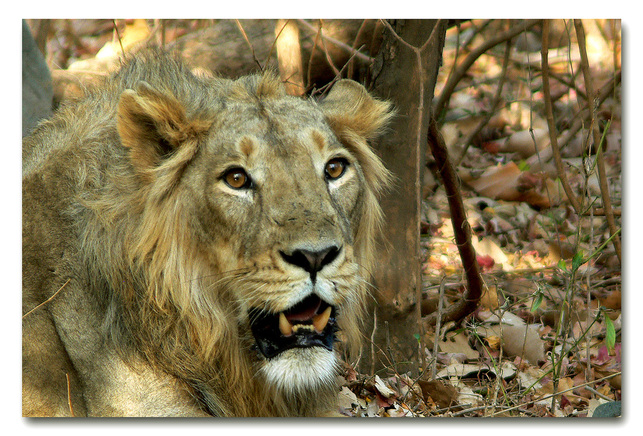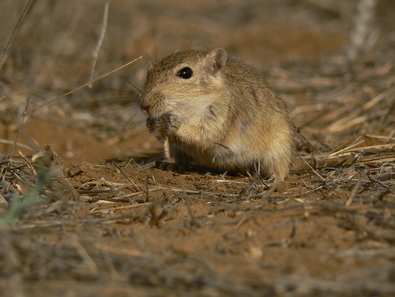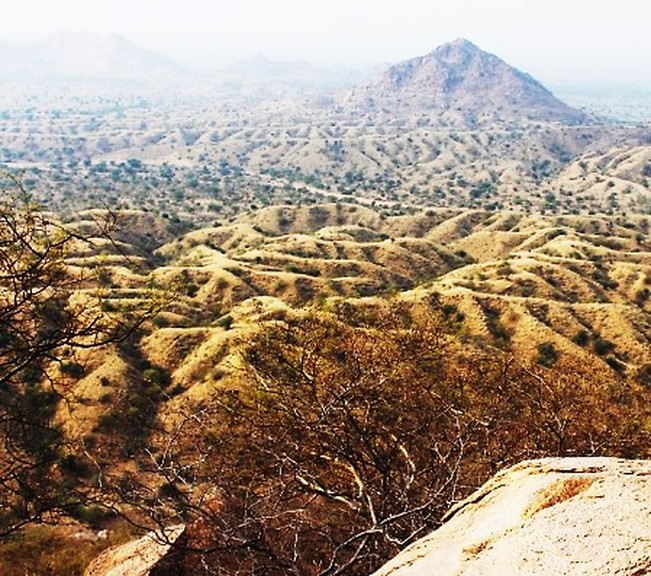To take a walk down the corridors of reminiscence, the Wildlife Institute of India (WII) celebrated its first Alumni meet on 21st and 22nd August, 2014. The meet was organized in chorus with the Annual Research Seminar and was graced by over 350 dignitaries from various parts of the country. Conservation peers of the country were present for this august gathering and some prominent of them included Shri H.S. Panwar, Shri Vinod Rishi, Dr. A.J.T. Johnsingh, Dr. H.S. Pabla, Dr. Ravi Chellam, Dr. N.V.K. Ashraf, Dr. M.K. Padalia, Dr. G.C. Bhimani, Dr. Yashveer Bhatnagar, Dr. M.D. Madhusudan, Dr. Shomita Mukherjee, Dr. Diwakar Sharma, Dr. Kavita Ishwaran, Dr. Suhel Qader, Dr. Pranav Trivedi and many others.
By Ranjana Pal Jalore Wildlife Safari
Several Jirds bustled into their holes as we drove through the dirt road. I felt apologetic for disturbing these small burrowing rodents, who were busy feeding on the recently blossomed Bui flower (Aerva javanica). Just as we drove away, the Jirds were back to their business and we entered the territory of Jalore Wildlife Safari (henceforth JWS). The park (400 hectares) is situated few kilometers away from Jalore City, near Dhavla village, in Rajasthan. Jalore being a part of the great Indian Thar Desert is characterised by sandy trails, flat savanna, undulating grass bunds and is surrounded by the isolated Eserna range of hills and rocky ridges. The famous Jalore fort and Amba mata temple lies at a distance of 13 km from the park. By Subrata Gayen
India is a watershed of historical, philosophical and scientific ideologies. The concept of harmonious coexistence with animals and other natural resources is quite old in the country. However, it is only in recent times that we started questioning the age-old values and practices of our forefathers. At this era of urbanization, with development being imperative; coexistence may not any longer remain as a natural way of life. It becomes a crucial challenge for mankind. Let us focus on terrestrial carnivores now. Although the damage caused by snakes might be higher than carnivores in our country, but our psychology of fear for large carnivores makes us more sensitive to carnivore related conflicts than reptiles. Can we stop conflict? Or, should we simply manage it? And if yes, how and at what level? Should our livelihood securities and pace of development be compromised while giving priority to conservation agendas? Or, should we eradicate the problem animals totally? What, why, when, where and how? By Kamlesh K Maurya There are some new openings in WWF- India. Please see the links below.
 Dr Kamlesh K Maurya completed his Doctoral Degree in wildlife science from WII, where he studied the ecology of the Indian Fox (Vulpes bengalensis) to understand how the Indian fox coexist in a mid size carnivores ecosystem and various costs and benefits associated with dispersal in the Indian foxes in semi wild landscape of Kutch. After that he joined WWF India as Senior Project Officer-Tiger Conservation Programme.
By Kausik Banerjee
 Nesting turtle Nesting turtle Phew! Its that time of the year again. It is the season when sea turtles come in very large numbers on the beaches of Odisha to nest. The nesting sites receive so many turtles at the same time that it turns into a turtle ‘party’ zone.. However, for people counting them, it is a backbreaking exercise. Before I delve further into my ramblings, I shall in my capacity explain to you this amazing phenomenon called ‘Arribada.’
 Large carnivores have always been a source of fascination for people and our relationships with them vary from awe and inspiration to fear and loathing. More than any other animals, carnivores have forced us to move from ecosystem theory to ecosystem management and conservation with a focal shift from species to systems and from science vs. management to science and management. Large carnivores often provide the ultimate test of society’s willingness to conserve wildlife and thus have traditionally served as a charismatic conservation flagship worldwide. Nevertheless, recent assessments of the conservation status of carnivores present an alarming picture of ongoing declines and range contractions. Although carnivore conservation across the globe -- and particularly in an agrarian country like India -- is fraught with human dominations of potential habitats, poaching and fragmentation, the Gir lions in the westernmost state of Gujarat, India, have an altogether different story to narrate. By Kausik Banerjee
By Kausik Banerjee
Nature Kaleidoscope is not only a voice of young researchers at WII, it has an edifying role as well. It has often been felt at WII that majority of early or mid-career students remain perplexed about the scopes and opportunities in the conservation field. Most common FAQs humming in the campus are like these: ‘what are the international forums (seminars, meetings) where I can discuss my findings’, ‘where and when should I write for a grant proposal as my project is terminating shortly’, ‘is there any training workshop or field visit course through which I can learn something new’ and so on. Sometimes a student knows about a conference, nevertheless slips to apply for it after forgetting the deadlines. BWII recognizes these and therefore we have come up with a relevant section (News and Opportunities) shown as a white button link in the right hand side of our blog page. We would attempt to make this a regular fortnightly column where our editorial team would inform the onlookers about the upcoming events and research grants in the conservation field. We would try our best to update you well in advance so as to enable you to grab these opportunities. We would also urge our readers to enrich our repository by regularly contributing such news bytes. Finally, on behalf of BWII I welcome you to this important section of our blog. Please keep an eye on this section and avail of some top opportunities in our field.  Indian desert jird 1_photo credit IP Bopanna Indian desert jird 1_photo credit IP Bopanna By Divya Ramesh
When my grandfather used to leave little morsels of grain for the crows (who represent forefathers according to the Hindu culture) every morning, along with the crows there would always be a cautious furry squirrel or two partaking in the free food. This three-striped palm squirrel, favourably called anil in Tamil, had me bewitched from the first time I saw it, with its shifty eyes, always ready to scurry away at the slightest suspicion of danger. I would gawk at it until all the grain was gone, and eagerly wait for the next morning. With my grandfather's passing, no one else practised this ritual and with time, I guess I forgot about it too. I like to believe that it was this experience as a child that somehow subconsciously stayed with me and resurfaced almost 17 years later when I was running out of time to figure out a masters' thesis project at the Wildlife Institute of India (WII). I saw the Indian desert jird for the first time in Kachchh, Gujarat, during a short holiday that quickly turned into a reconnaissance for the project. These were social rodents that lived in an underground burrow system that I'm sure requires in-depth (at least up to a metre!) understanding of soil architecture. Their popping in and out of different burrow holes every few minutes reminded me of the arcade game Whac-A-Mole I'd seen in movies, of course without the violent excitement of wanting to hit the creature on the head! I tried to see how close I could go before they would run down the burrows, and they were surprisingly tame, especially if I was so slow as to appear unmoving. It was love at first sight, for me at least; I'm not sure they felt the same way. I wanted to study animal behaviour and the jirds looked very promising. |


 RSS Feed
RSS Feed